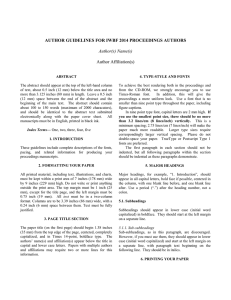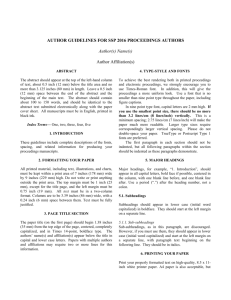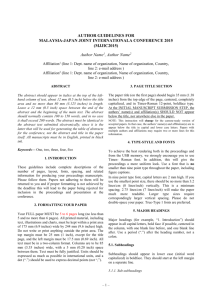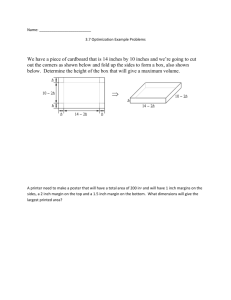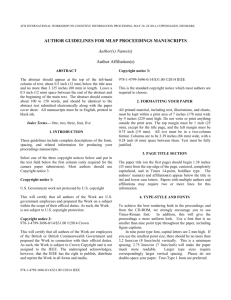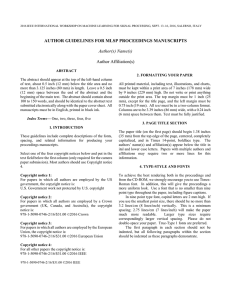Digital Proceedings Template Document
advertisement
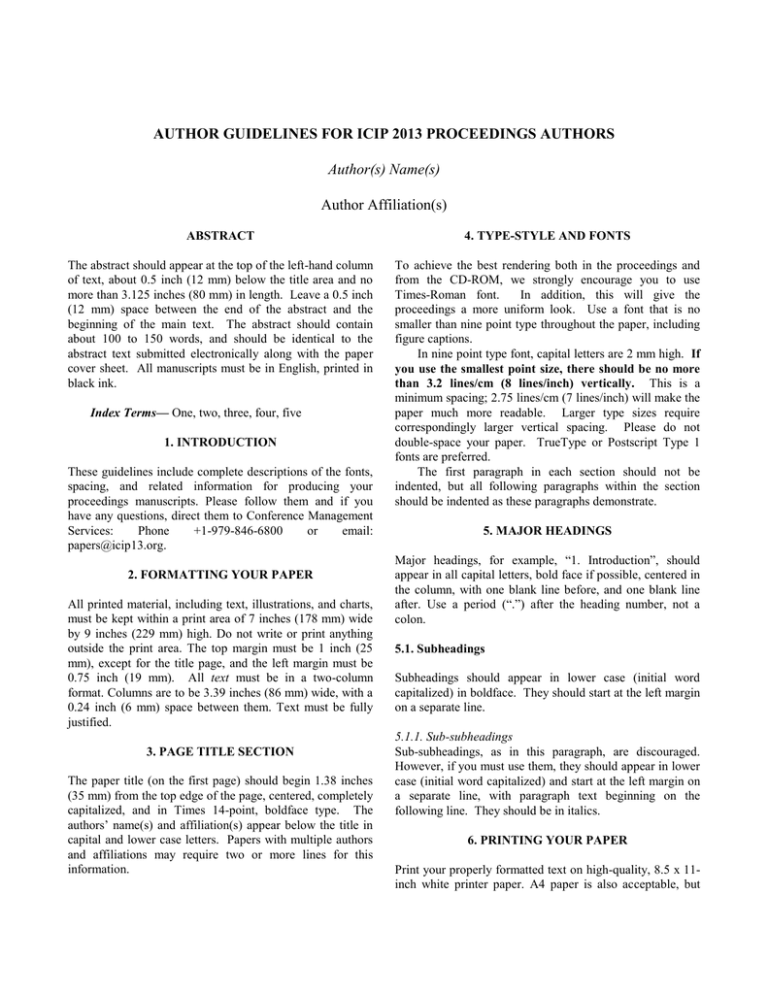
AUTHOR GUIDELINES FOR ICIP 2013 PROCEEDINGS AUTHORS Author(s) Name(s) Author Affiliation(s) ABSTRACT 4. TYPE-STYLE AND FONTS The abstract should appear at the top of the left-hand column of text, about 0.5 inch (12 mm) below the title area and no more than 3.125 inches (80 mm) in length. Leave a 0.5 inch (12 mm) space between the end of the abstract and the beginning of the main text. The abstract should contain about 100 to 150 words, and should be identical to the abstract text submitted electronically along with the paper cover sheet. All manuscripts must be in English, printed in black ink. To achieve the best rendering both in the proceedings and from the CD-ROM, we strongly encourage you to use Times-Roman font. In addition, this will give the proceedings a more uniform look. Use a font that is no smaller than nine point type throughout the paper, including figure captions. In nine point type font, capital letters are 2 mm high. If you use the smallest point size, there should be no more than 3.2 lines/cm (8 lines/inch) vertically. This is a minimum spacing; 2.75 lines/cm (7 lines/inch) will make the paper much more readable. Larger type sizes require correspondingly larger vertical spacing. Please do not double-space your paper. TrueType or Postscript Type 1 fonts are preferred. The first paragraph in each section should not be indented, but all following paragraphs within the section should be indented as these paragraphs demonstrate. Index Terms— One, two, three, four, five 1. INTRODUCTION These guidelines include complete descriptions of the fonts, spacing, and related information for producing your proceedings manuscripts. Please follow them and if you have any questions, direct them to Conference Management Services: Phone +1-979-846-6800 or email: papers@icip13.org. 2. FORMATTING YOUR PAPER All printed material, including text, illustrations, and charts, must be kept within a print area of 7 inches (178 mm) wide by 9 inches (229 mm) high. Do not write or print anything outside the print area. The top margin must be 1 inch (25 mm), except for the title page, and the left margin must be 0.75 inch (19 mm). All text must be in a two-column format. Columns are to be 3.39 inches (86 mm) wide, with a 0.24 inch (6 mm) space between them. Text must be fully justified. 3. PAGE TITLE SECTION The paper title (on the first page) should begin 1.38 inches (35 mm) from the top edge of the page, centered, completely capitalized, and in Times 14-point, boldface type. The authors’ name(s) and affiliation(s) appear below the title in capital and lower case letters. Papers with multiple authors and affiliations may require two or more lines for this information. 5. MAJOR HEADINGS Major headings, for example, “1. Introduction”, should appear in all capital letters, bold face if possible, centered in the column, with one blank line before, and one blank line after. Use a period (“.”) after the heading number, not a colon. 5.1. Subheadings Subheadings should appear in lower case (initial word capitalized) in boldface. They should start at the left margin on a separate line. 5.1.1. Sub-subheadings Sub-subheadings, as in this paragraph, are discouraged. However, if you must use them, they should appear in lower case (initial word capitalized) and start at the left margin on a separate line, with paragraph text beginning on the following line. They should be in italics. 6. PRINTING YOUR PAPER Print your properly formatted text on high-quality, 8.5 x 11inch white printer paper. A4 paper is also acceptable, but please leave the extra 0.5 inch (12 mm) empty at the BOTTOM of the page and follow the top and left margins as specified. If the last page of your paper is only partially filled, arrange the columns so that they are evenly balanced if possible, rather than having one long column. 10. COPYRIGHT FORMS You must include your fully completed, signed IEEE copyright release form when you submit your paper. We must have this form before your paper can be published in the proceedings. 7. PAGE NUMBERING 11. REFERENCES Please do not paginate your paper. Page numbers, session numbers, and conference identification will be inserted when the paper is included in the proceedings. 8. ILLUSTRATIONS, GRAPHS, AND PHOTOGRAPHS Illustrations must appear within the designated margins. They may span the two columns. If possible, position illustrations at the top of columns, rather than in the middle or at the bottom. Caption and number every illustration. All halftone illustrations must be clear black and white prints. If you use color, make sure that the color figures are clear when printed on a black-only printer. 9. FOOTNOTES Use footnotes sparingly (or not at all!) and place them at the bottom of the column on the page on which they are referenced. Use Times 9-point type, single-spaced. To help your readers, avoid using footnotes altogether and include necessary peripheral observations in the text (within parentheses, if you prefer, as in this sentence). List and number all bibliographical references at the end of the paper. The references can be numbered in alphabetic order or in order of appearance in the document. When referring to them in the text, type the corresponding reference number in square brackets as shown at the end of this sentence [2]. An additional final page (the fifth page, in most cases) is allowed, but must contain only references to the prior literature. [1] A.B. Smith, C.D. Jones, and E.F. Roberts, “Article Title,” Journal, Publisher, Location, pp. 1-10, Date. [2] Jones, C.D., A.B. Smith, and E.F. Roberts, Book Title, Publisher, Location, Date.
